

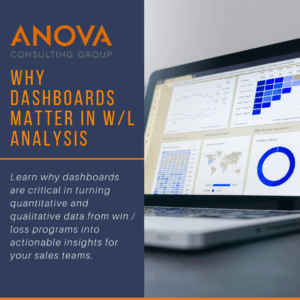 This blog was written by Philip Trevisan, Consultant at Anova.
This blog was written by Philip Trevisan, Consultant at Anova.
In an increasingly quantitative world, nearly every program we use spits out data in some form. Sales leaders naturally want to wrangle that raw data into something digestible – and one of the most common ways is on a dashboard. Before entering the market research space, I worked in management consulting, where I saw clients frequently ask for dashboards to help them make sense of complex, disparate, or overwhelming amounts of data. Oftentimes, they just wanted to see their data displayed – but dashboards are important for so much more than that.
Dashboards are a core part of a successful Win / Loss program. Beyond just displaying quantitative data in an easy-to-understand way, they offer several larger benefits:
Successful dashboards have a few key characteristics. At Anova Consulting, we’ve built the myView dashboard, a web dashboard around these principles:
Interested in learning more?
Anova Consulting Group offers real-time insights on our clients’ Win / Loss programs through the myView dashboard, a secure web portal that provides our clients with real-time access to their research results. Click here to learn how myView can help your organization win more business.
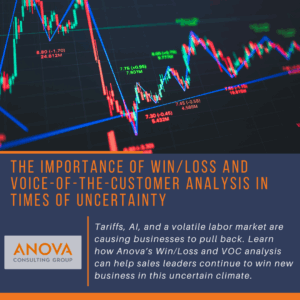 This blog was written by Philip Trevisan, Consultant at Anova.
This blog was written by Philip Trevisan, Consultant at Anova.
Businesses across the United States and the world are facing unprecedented uncertainty. Tariffs, a shaky labor market, and the ever-shifting potential impacts of AI leave leaders uncertain of how to react and plan their strategies for the next quarter, let alone next year. In periods of intense uncertainty, you need to have an accurate understanding of the sentiment of your potential and current clients to grow and sustain your business. Win/loss and voice-of-the-customer (VoC) analysis helps that happen.
Importance of Win / Loss and Churn Analysis in Periods of Uncertainty
Win/loss analysis is crucial for business and sales leaders to navigate periods of uncertainty like the one we now face. Win/loss analysis is the systematic review of closed sales opportunities, both wins and losses, to uncover the real reasons behind customer decisions. This process goes beyond surface-level feedback, digging into the factors that truly influence buying behavior, such as sales approach, product features, pricing, customer experience, and competitive positioning. Here’s why it matters in times of uncertainty:
Why Win/Loss Research is Critical in Uncertain Times:
In addition to loss debriefs, an interview with a departed client (a churned client) puts the spotlight on why customers did not choose to continue a relationship with a company.
These churn interviews provide many of the benefits of loss interviews, with a few additional benefits. If, for example, missing functionality on a platform is a key reason why a company is both losing new business and experiencing churn, that clearly highlights a competitive gap in their solution. If a key feature of the platform is being cited as a strength in win interviews but subsequently shows up as a churn driver, that indicates a lack of consistent experience around that tool, either because of unrealistic expectation setting from the sales team or insufficient follow-through on the CX side.
Importance of Voice-of-the-Customer Analysis in Periods of Uncertainty
Win/loss analysis is critical to winning new business in periods of uncertainty, but how do you retain your existing customers? This is where voice-of-the-customer (VoC) analysis enters the picture. VoC feedback is a way to collect and analyze customer feedback to better understand their needs, expectations, and pain points. By listening to VoC feedback, you can identify addressable areas of your product and service with direct benefits to your customers. Important in normal business environments, VoC analysis becomes essential in periods of high uncertainty.
Why VoC Research is Critical in Uncertain Times:
Interested in learning more?
Anova Consulting Group offers industry-leading Win / Loss and VoC analysis for businesses across a range of industries. Through our myView dashboard, you and your team can unlock real-time insights from our research. Click here to learn how Anova can help your organization navigate this period of turbulence and uncertainty.
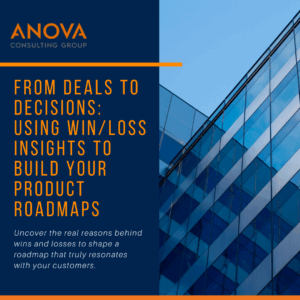 This blog was written by Brendon Attridge, Sr. Engagement Manager
This blog was written by Brendon Attridge, Sr. Engagement Manager
In the fast-paced world of technology, understanding why you win or lose deals is more than a sales concern, it’s a strategic imperative. And while insights into the performance of your sales team might be the first thing you think of when it comes to Win/Loss research, the fact that win/loss programs often sit with, and are managed by product marketing teams, means tech companies are well positioned to use win/loss feedback to inform and shape their product roadmaps.
What Is Win/Loss Analysis?
Win/loss analysis is the systematic review of closed sales opportunities—both wins and losses—to uncover the real reasons behind customer decisions. This process goes beyond surface-level feedback, digging into the factors that truly influence buying behavior, such as product features, pricing, customer experience, and competitive positioning.
How Win/Loss Feedback Helps Product Managers
Product managers often face a flood of feature requests and ideas. Win/loss feedback helps cut through the noise by revealing which features actually impact buying decisions. If a missing capability is consistently cited in lost deals, it becomes a clear candidate for prioritization on the roadmap.
By tracking which competitors you lose to—and why—you gain a nuanced view of the market. Is a rival’s new mobile app or integration capabilities tipping the scales? These insights allow you to benchmark your product, identify gaps, and make informed decisions about where to invest development resources.
Regular win/loss interviews highlight emerging trends, such as new customer pain points or shifts in industry expectations. Early feedback enables tech companies to anticipate changes, adapt their offerings, and avoid being blindsided by disruptive technologies.
Win/loss brings the voice of the customer directly into product planning. Reviewing and analyzing actual buyer feedback, instead of relying on internal assumptions, enables product teams to validate their strategies and ensure the product roadmap aligns with current market realities.
How To Put Win/Loss Insights Into Action
| Step | Description |
| Collect Feedback | Gather detailed input from both won and lost deals, ideally through direct buyer interviews. |
| Analyze Patterns | Identify recurring themes—missing features, pricing objections, competitor strengths, etc. |
| Share Insights | Distribute findings across product, marketing, and sales teams for cross-functional alignment. |
| Prioritize Actions | Use data to inform roadmap decisions, focusing on changes that will move the needle. |
| Track Impact | Monitor how roadmap adjustments affect future win rates and customer satisfaction. |
Use Win/Loss to Foster a Culture of Continuous Improvement
Win/loss programs help foster a culture of learning and adaptation. This culture starts from the top. With sufficient support from the C-suite and senior Product leadership, a focus on market feedback helps ensure that product development is always listens to prospects and customers and stays current with the latest market realities.
Key Steps in this process:
Conclusion
For tech companies, win/loss analysis is a powerful engine for product innovation and market success. By systematically capturing and acting on buyer feedback, organizations can build roadmaps that reflect real-world needs, outpace competitors, and deliver products that win in the marketplace.
 This blog was written by Harriet Peabody, Senior Research Analyst.
This blog was written by Harriet Peabody, Senior Research Analyst.
Understanding why customers leave is just as important—if not more so—than understanding why they stay. Churn interviews are a powerful component of Voice of the Customer (VoC) analysis, giving businesses a direct line into the motivations, frustrations, and unmet needs that drive customer departure.
But conducting these interviews effectively is an art and a science. Done well, churn interviews can uncover goldmines of insight to fuel product improvements, retention strategies, and stronger customer relationships. Done poorly, they risk sounding like post-mortems or half-hearted attempts to win back goodwill.
So, how do you do them right? Let’s break it down.
Why Churn Interviews Work
Churn interviews tap into a unique psychological moment: your customer has already decided to leave. While that might seem like a closed door, it’s actually an open window. They often feel freer to be honest, less concerned about politeness or loyalty, and more willing to share the truth—raw and real.
These insights go deeper than what surveys can provide. They help you understand root causes rather than surface-level symptoms, and they reveal patterns that even your happiest customers might not articulate.
When to Conduct a Churn Interview
Timing is everything. Here’s how to time your outreach for maximum impact:
Within 7-14 Days of Churn
Right after a customer churns, their experience is still fresh. Emotions may still be raw (especially if they had a bad experience), but that immediacy allows for more accurate recall and richer detail.
Not Immediately After Cancellation
Give it a little breathing room. Immediately following the cancellation, the customer may be too frustrated—or simply not interested in engaging. Waiting a few days shows respect for their decision and gives them time to cool down, which can lead to a more thoughtful conversation.
Schedule Considerately
Ask for a brief 15-30 minute call, and position it as a feedback conversation—not a sales pitch. Make it clear you’re not trying to win them back on the spot; you’re trying to understand and learn.
What to Ask: Powerful Questions That Reveal the Truth
Here are some proven churn interview questions that go beyond the generic:
This open-ended question allows the customer to frame their own story, giving you context before you dive into specifics.
Understanding their initial goals can help you pinpoint where expectations started to misalign.
This question helps isolate the moment things started to go wrong—critical for understanding preventable churn.
This helps you assess which retention levers (better support, feature rollout, pricing tweaks) might have mattered most.
This question is key to collecting competitive intelligence. Understanding what drew them elsewhere tells you what your competitors are doing better—or simply communicating more effectively.
This question acts as a catch-all to collect any important information that may have been missed by the previous questions and shows the respondent that you value any insight they have to provide.
Best Practices to Make It Work
Even with the right timing and questions, churn interviews can fall flat without the right approach. Here are some tips to increase success:
Treat it like a conversation, not an interrogation. Customers can sense canned questions or hidden sales agendas from a mile away.
The goal isn’t to correct them or explain what went wrong. Just listen. Validate their feelings—even if you disagree. This isn’t about blame; it’s about learning.
With permission, record the call to review later or keep detailed notes. Use qualitative analysis to uncover trends across multiple interviews.
Thank the customer for their honesty, and let them know how you plan to use their feedback. It shows respect and might even soften their perception of your brand, leaving the door open for future re-engagement.
Turning Churn into Change
Churn interviews aren’t just a box to check in your VoC program—they’re a strategic tool for growth. When you consistently gather, analyze, and act on churn feedback, you can:
In short, you stop guessing and start knowing.
Losing a customer always stings. But with the right churn interview strategy, that loss can fuel something far more valuable than a quick winback: clarity. And clarity is the foundation for building products, services, and experiences that truly resonate.
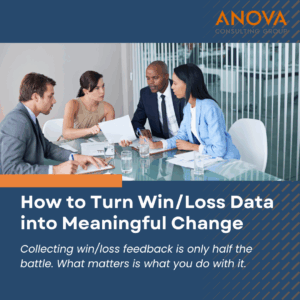 Part 4: Acting on Win / Loss Data: Moving from Insight to Impact
Part 4: Acting on Win / Loss Data: Moving from Insight to ImpactAfter win / loss data has been collected, getting value from the research will ultimately come down to what is done with the research. There are many ways to do this, stretching from short term to ongoing, long-term actions.
In the short term, use individual data points as coaching opportunities. Feedback from individual situations can be used to color in blind spots of what happened in a specific deal so that sellers can learn and improve for their next opportunities.
In the medium term, after multiple interviews have been completed, identify and discuss emerging trends. When discussing these aggregate findings, do so in a cross-functional environment so that team members from product, sales, marketing, and other parts of the organization can share their perspective on why certain trends are beginning to appear. There may be initial findings with deeper truths, or they might be red herrings, but the cross-functional discussion will help promote collaboration and alignment across teams no matter what the finding is.
Over the long term, as sample sizes reach levels where the findings can be acted on, look not only to uncover insights, but identify key takeaways. Assign action owners responsible for driving change based on key takeaways. As more interviews are completed, look to see any changes in sentiment from prospects that will indicate whether or not you have moved the needle.
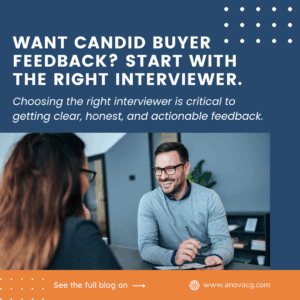 Part 3: Choosing Internal vs. Third-Party Interviewers
Part 3: Choosing Internal vs. Third-Party InterviewersOn your win / loss journey, once you know who you are going to talk to (prospect identification) and what you are going to talk to them about (interview guide design), the next decision is who will be talking to them.
The most fundamental question is whether to use internal resources or to rely on third-party interviewers. Each option has benefits. To decide which is the best option, consider these elements:
• Product expertise: The goal is to have the interviewee feel like they are having an intelligent conversation with someone who understands their business. No one will know your product more than internal resources, but highly trained third-party interviewers are often preferable as they are unbiased and therefore less likely to distort or influence the buyers perspective.
• Interviewing expertise: Interviewing is an art form. With the ultimate goal of collecting the breadth and depth of information necessary to take action, deploying interviewers who are skilled in asking questions and encouraging respondents to provide more detail can be the difference between a program that “checks the box” and one that can be used to drive strategic decisions. Among these skills are probing, being curious, using silence as a way to get the interviewee to fill the space and provide more detail, and also making the interviewee comfortable enough so that they do open up and provide more than surface level answers.
• Bandwidth: Particularly when thinking about a robust program consisting of dozens of interviews, bandwidth is an important consideration. It is not just the time to conduct the interviews either. Having dedicated time to reach out to schedule interviews is necessary to ensuring strong response rates. Writing up the transcript also takes time. Even if you are using AI to help with the transcription, the dialogue should still be reviewed and edited for clarity. This is where third parties can be a major value-add, as completing the interviews is their sole focus, as opposed to internal resources who likely have other competing priorities.
• Objectivity: Lastly, but perhaps the most important factor to consider, is objectivity. Anova’s research indicates that 60% of the time a salesperson does not get the full and accurate truth as to why they won or lost a deal if they debrief with a prospect themselves. This doesn’t mean a salesperson is doing anything nefarious. Prospects may be reluctant to give the person direct and honest feedback. Having someone internal who is removed from the situation (e.g., product manager / marketer) is a good way of increasing objectivity, and using a third party is the best way to obtain unbiased, independent feedback.
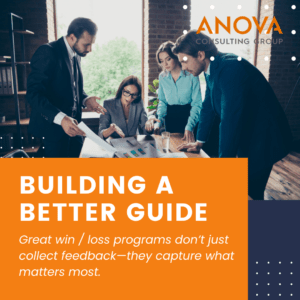 Part 2: Designing the Right Interview Guide
Part 2: Designing the Right Interview GuideCritical to win / loss program success is capturing the right information. Win / loss is a powerful tool in part because of the breadth of customer feedback it can collect. It is normal for feedback to cover sales, product, pricing, services, brand / market positioning, and of course competitive comparisons.
In a perfect world companies would be able to collect as much feedback as possible across all these areas in each interview, however respondents don’t have unlimited time to give. This makes interview guide design really an optimization exercise.
To maximize a program’s value, questions should be aligned to the biggest areas of focus that were identified by stakeholders in the buy-in stage. This will ensure that above all else, feedback is maximized in those influential areas that are most responsible for driving wins and losses.
Beyond concentrating on those critical areas of focus, interview guide design should also achieve a balance between the following types of questions:
One last thing to consider: the interview guides shouldn’t be set in stone. As you collect feedback and/or your business priorities change, adapt the guide so you are constantly optimizing your feedback loop.
Ultimately, win / loss interview guides can take all shapes and forms. With a little thought into areas you want to focus on, and a balanced approach for collecting feedback, the guide can be a vital tool for collecting actionable feedback.
 After over 20 years of working with companies to help them implement and build successful win / loss programs, we’ve heard every question under the sun. This series will explore the areas we often get asked about the most.
After over 20 years of working with companies to help them implement and build successful win / loss programs, we’ve heard every question under the sun. This series will explore the areas we often get asked about the most.
As with many things in life, “it depends” is a common answer we resort to. Rarely is there a one size that fits all or off-the-shelf blueprint for win / loss program success. However, there are frameworks and things to keep in mind to help you navigate these common areas of curiosity.
Part 1: Getting Executive Buy-In for Win/Loss Analysis
Getting Executive Buy-In is firmly entrenched in the curriculum of “Win / Loss 101”. And yet, it is a step that many organizations try to skip or treat as a check the box exercise. Even for the companies who really understand its importance, there is the question of how to effectively involve senior stakeholders with the program. This blog will explore both why executive buy-in is important, as well as how to get it.
Why Executive Buy-In is Important:
Think of a plane taking off on a cloudy day. Typically, there is some turbulence before the plane reaches its cruising altitude. Similarly, a win / loss program will run more smoothly if it reaches the clearer air space of the highest rungs of an organization.
A win / loss program is a great example of “you get what you put in”. Strong efforts will yield strong results. In a world of competing priorities, knowing that stakeholders are behind the program and are looking for results from it helps to ensure the required levels of attention are paid to the program to ensure success.
Said differently, executive buy-in can be a good carrot. It can also be a good stick to ensure program compliance from sellers to ensure they are not dodging the program or not providing accurate contact information to collect feedback. When an executive makes it known the program is not optional, and the results will not be used as a “witch hunt” but to help the entire organization improve and win more, the raw inputs (buyer contact information) are easier to access.
Executive buy-in also positively impacts the smoothness of other program operations:
Getting Executive Buy-In
Now the part that has many organizations struggling: truly getting executives to buy-in.
In general, the best way to secure executive support is by aligning the program to their areas of interest. This can be in terms of who you talk to (executives tend to care about the biggest customers, or maybe your organization is rolling out a new product and they want initial feedback from those early adopters) as well as what you talk to them about (head of sales interested in how effective you were at differentiating against the competition? Make sure to ask about that specifically).
Be sure to also tailor your communication to the individual stakeholder you are interfacing with. When talking with sales leaders, emphasize how win / loss can positively impact win rates (Gartner says by up to 50%). When talking to the CMO, highlight how the research will help refine messaging and collect competitive insights. When working with the CEO or head of the business, be sure to note how the program will help ensure strong levels of customer centricity, as well as build strong internal cultures by accentuating values such as a growth mindset and commitment to feedback.
 Building and Leveraging Your Network: The Power of Trust and Brand
Building and Leveraging Your Network: The Power of Trust and Brand
Your network isn’t just a list of connections—it’s a critical driver of business growth. In every industry, success depends on how well you cultivate relationships, establish trust, and position your brand. But trust and brand don’t operate the same way in every market.
In mature industries, trust built over time plays a key role in decision-making, while in fast-moving, innovation-driven markets, brand credibility and cutting-edge solutions take priority. Understanding these nuances allows businesses to accelerate growth, close deals more effectively, and strengthen long-term customer relationships.
To maximize your network’s impact, you need a strategy that not only builds connections but also leverages them for real business outcomes.
The Role of Trust in Business Networks
Trust is the foundation of any successful relationship, personal or professional. But in business, the weight of prior relationships differs depending on the type of market you operate in.
Building Your Brand to Strengthen Your Network
Your brand is an extension of your reputation, and in many cases, it plays a pivotal role in growing and maintaining a strong business network. However, the impact of brand also varies between market types.
Using Your Network to Strengthen Relationships and Drive Growth
Building a network is only the first step—leveraging it effectively is what drives sustained growth. Here are a few key strategies for using your network to strengthen relationships and expand your reach:
A strong network is built on trust, strengthened by brand reputation, and expanded through strategic engagement. Understanding how these factors influence decision-making can refine your approach, deepen your relationships, and accelerate growth in any market.
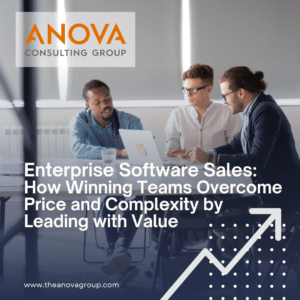
Why do enterprise software sales teams win and lose deals? Traditional thinking would hypothesize that for high-dollar value, complex software platforms, the strength of their solution drives wins while losses are driven by a perception of higher price points and more difficult implementations, especially compared to less robust, cheaper, point solutions. Does the difference between winning and losing truly come down to price and a perception of being easy to work with? If that thinking holds true, how can enterprise software companies win despite being perceived as more expensive and more difficult to implement than their competitors?
This report explores how in enterprise software deals, winning in these competitive situations is predicated more on demonstrating value rather than absolute cost or perception of effort involved. In order to fully examine this, Anova analyzed findings from thirteen win / loss programs conducted between 2022 and 2023 focused on complex, high value enterprise software deals. Our goal was to understand what winning sales teams do differently to set their solutions apart and ultimately win more. Company names in this case study have been scrubbed and will be referred to as the Client.
In those thirteen programs one of the most interesting findings was that when our Client won, in just over half of those winning situations their newly acquired customer was actually more satisfied with a competitor’s price point. Despite being at a pricing disadvantage, the Client was still able to win because they proved their solution would drive superior value for the customer. Conversely, when we looked at the inverse loss data, 100% of the time when our Client lost customers rated themselves as more satisfied with both price point and expected value.
Figure 1 illustrates one specific situation representative of this finding. When this Client won, satisfaction with its value exceeded that of its top competitor (75% versus 50%), even though it fell behind its competitor in terms of satisfaction with price levels (50% versus 100%). In contrast, when the Client lost, the winning vendor outperformed it in both value satisfaction and pricing satisfaction.
Figure 1 Satisfaction with Price Levels and Value in Wins and Losses Between Clients and Competitors

Additionally, in our Clients’ winning situations, an average of just 48% of prospects were satisfied with their expected ease of implementation. Said another way, more than half of newly won customers expected to be dissatisfied with their selected vendor’s implementation process yet still felt that value of the implemented solution would outweigh the pain of installation.
It becomes clear that the expectation of high value can outweigh pricing and implementation concerns. So, the question then becomes: how can software sales teams become successful at proving their value to their customers?
Click here to read the full case study.